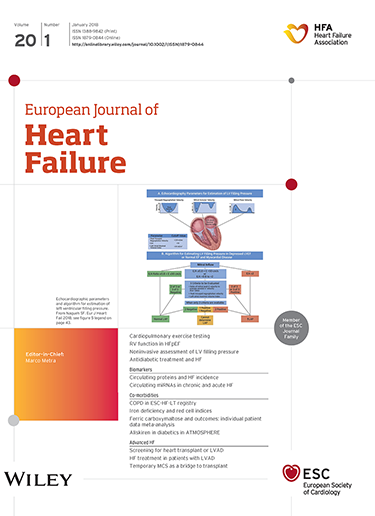心力衰竭去充血期间的水电解质稳态
IF 16.9
1区 医学
Q1 CARDIAC & CARDIOVASCULAR SYSTEMS
引用次数: 0
摘要
心力衰竭时,钠潴留通常与水潴留不成比例,也可能与氯潴留不成比例,需要排泄其他阳离子(即钾、镁和氢)。肾脏内稳态机制保持氯离子水平的平衡,使其成为血管内张力的主要调节剂。过量的全身钠储存和钾消耗增加了对脱水的脆弱性,尤其是在细胞内。在失代偿时,细胞外体积扩大,钠和氯超载,进一步增加钾的损失。虽然利尿剂对治疗体液超载至关重要,但它们会破坏重要的电解质和水分平衡。心力衰竭的利尿剂治疗产生不成比例的无电解质水排泄,进一步加剧钾的消耗,并导致与钠尿不成比例的氯化物损失。这可以通过允许自由电解质无水摄入,提供积极的钾和氯化物补充,并使用前期近端利尿剂来保持氯平衡来缓解。本文章由计算机程序翻译,如有差异,请以英文原文为准。
Water and electrolyte homeostasis during decongestion in heart failure
In heart failure, sodium retention generally occurs out of proportion to water retention and may occur disproportionate to chloride retention, requiring excretion of other cations (i.e. potassium, magnesium, and hydrogen). Renal homeostatic mechanisms keep chloride levels in balance, making it the primary regulator of intravascular tonicity. Excess total body sodium stores and potassium depletion increase the vulnerability to dehydration, especially in the intracellular compartment. With decompensation, extracellular volume expansion with sodium and chloride overload occurs, further enhancing potassium losses. While diuretics are vital to treat fluid overload, they derange important electrolyte and water balances. Diuretic therapies in heart failure produce disproportionate electrolyte‐free water excretion, further exacerbate potassium depletion, and cause chloride losses disproportionate to natriuresis. This can be mitigated by allowing liberal electrolyte‐free water intake, providing aggressive potassium and chloride supplementation, and using upfront proximal diuretics to preserve the chloride balance.
求助全文
通过发布文献求助,成功后即可免费获取论文全文。
去求助
来源期刊

European Journal of Heart Failure
医学-心血管系统
CiteScore
27.30
自引率
11.50%
发文量
365
审稿时长
1 months
期刊介绍:
European Journal of Heart Failure is an international journal dedicated to advancing knowledge in the field of heart failure management. The journal publishes reviews and editorials aimed at improving understanding, prevention, investigation, and treatment of heart failure. It covers various disciplines such as molecular and cellular biology, pathology, physiology, electrophysiology, pharmacology, clinical sciences, social sciences, and population sciences. The journal welcomes submissions of manuscripts on basic, clinical, and population sciences, as well as original contributions on nursing, care of the elderly, primary care, health economics, and other related specialist fields. It is published monthly and has a readership that includes cardiologists, emergency room physicians, intensivists, internists, general physicians, cardiac nurses, diabetologists, epidemiologists, basic scientists focusing on cardiovascular research, and those working in rehabilitation. The journal is abstracted and indexed in various databases such as Academic Search, Embase, MEDLINE/PubMed, and Science Citation Index.
 求助内容:
求助内容: 应助结果提醒方式:
应助结果提醒方式:


